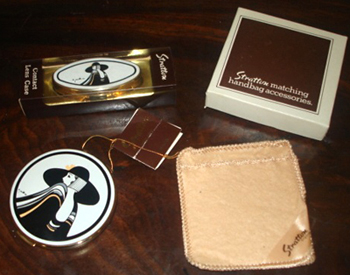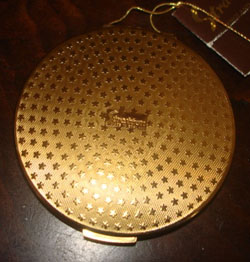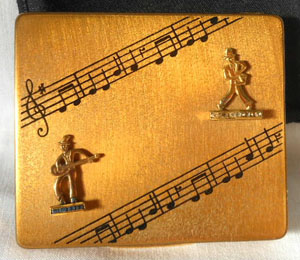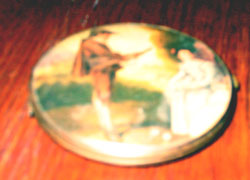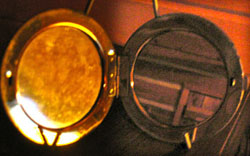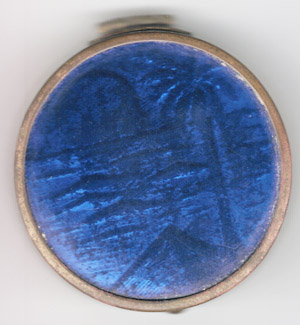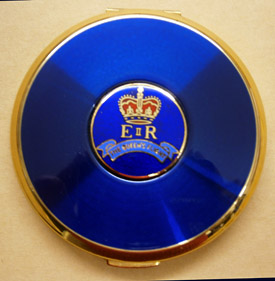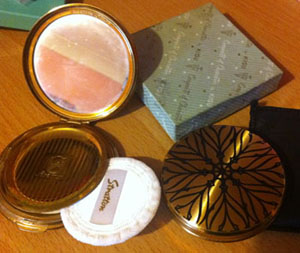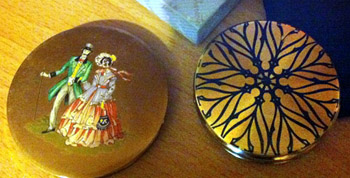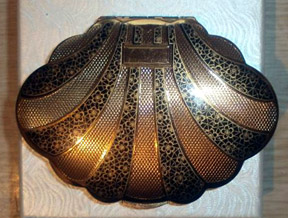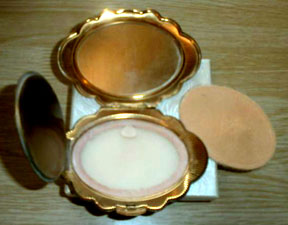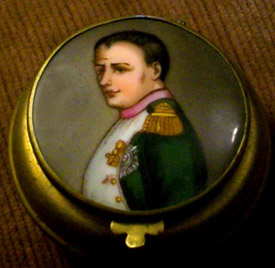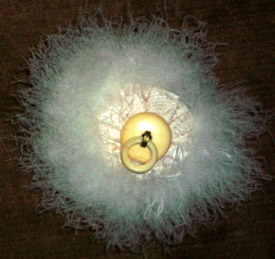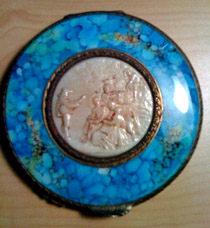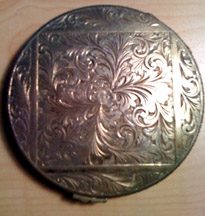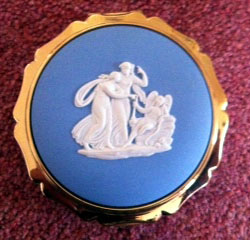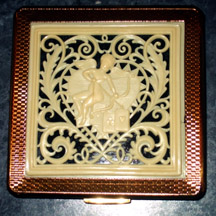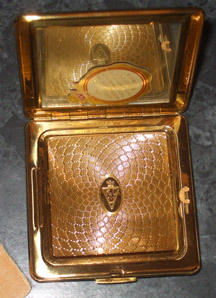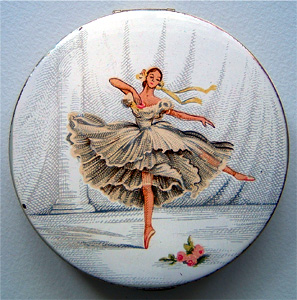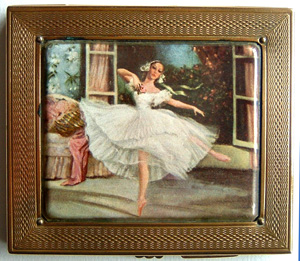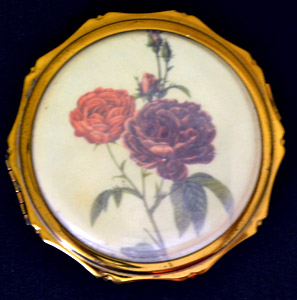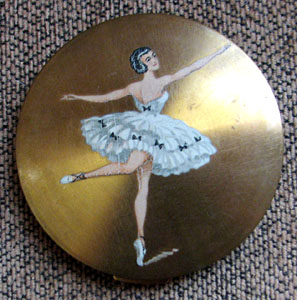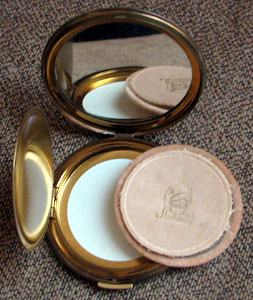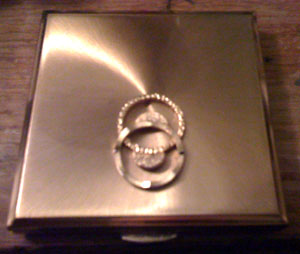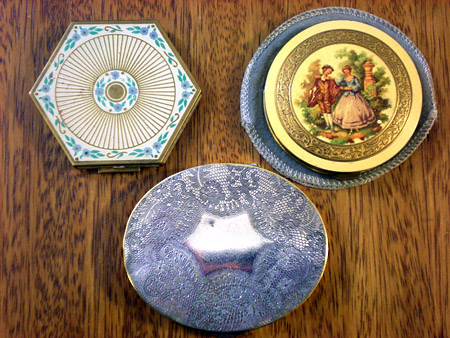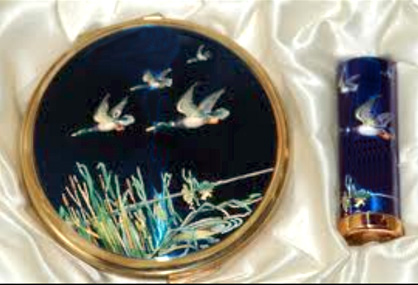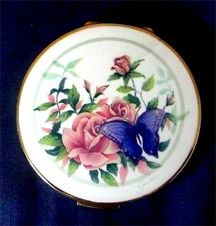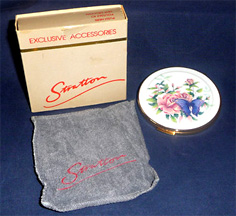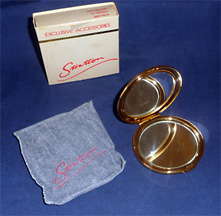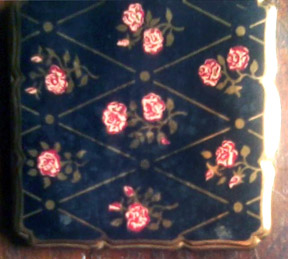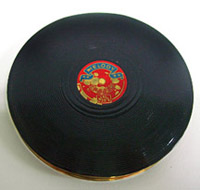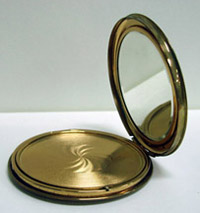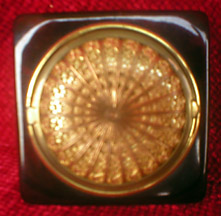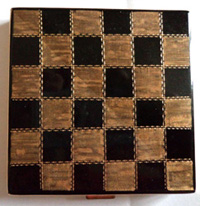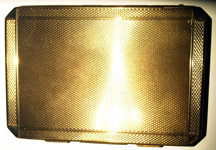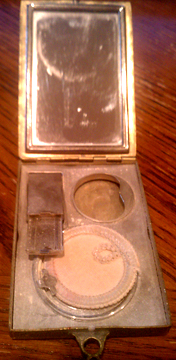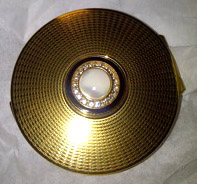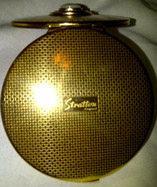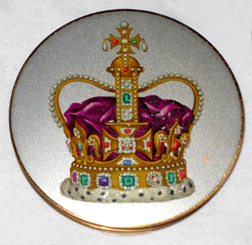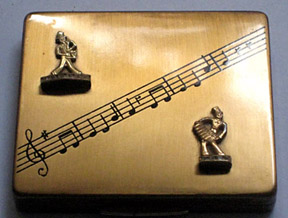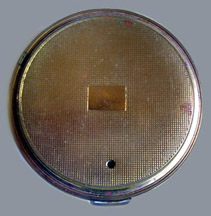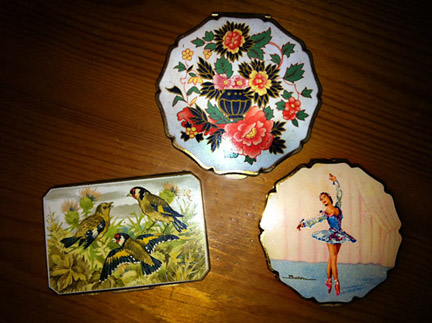|
QUESTIONS &
ANSWERS
8th March 2013
1st March 2013
27th February 2013
19th February 2013
17th February 2013
February 16th 2013
February 16th 2013
February 8th 2013
January 31st 2013
January 31st 2013
January 25th 2013
January 18th 2013
21st November 2012
7th November 2012
6th November 2012
Jenny Duncan replies: From
the catch on the inner lid of your compact it
looks as if your compact is by the British
manufacturer Kigu. Kigu made very beautiful
sterling silver compacts as well as silver and
gold-plated compacts. All sterling silver is
hallmarked, but plated articles are not. It is
difficult to tell from your photo, but the
interior seems to be gold-tone in colour and I
wonder if your compact is silver-plated and
efforts to clean it have removed some of the
silver plating to reveal the base metal
underneath? Unless you are certain that
your compact is silver, please never clean it
with silver polish as you will remove its
protective lacquer and ruin it.
Please take a look at the Kigu website http://www.vintage-compacts.com/, go to “Photo Gallery” and click on “Products 1950-60s” and then “Sterling Silver Series”. You will find a compact in the 51 Series Cat. Ref. 51-106, which resembles your compact, but is in sterling silver. You will see the hallmarks very clearly visible on the right-hand side below the catch in the inner lid. It is possible that Kigu also sold a silver-plated version, but without further research I cannot be certain of this. 29th October 2012
19th October 2012
12th October 2012
Jenny Duncan replies: You have two very attractive compacts, which are likely to date from the 1950s. Gwenda is a British brand and their products were made by a Birmingham-based company called Hussey Dawson Ltd. They were first popular in the 1930s, when the products were simply constructed and were inexpensive. Production resumed after World War II with a variety of styles in goldtone metal, and your Gwenda with a scalloped edge is less common. From your photo, it looks as if the transfer-printed ladies on the lid are wearing different styles of period costume. What do you think?
Compacts that had belonged to
our mothers can be a starting point for a
collection – it certainly was for me - and by
joining the BCCS you will be able to learn far
more about these really attractive
collectables! 5th October 2012
Jenny Duncan replies: Your daughter-in-law has a very attractive compact. These rococo style patterns of leaves and flowers can be found on some compacts and lipstick cases, believed to be of Italian origin. As it is marked 800, it is possible that your compact is silver, as these numerals may be found on some Italian silver, indicating the fineness of the silver. Without photos of the interior it is not possible to tell whether it was made for loose powder. To find out more about Italian silver, please take a look at this fascinating website by American compact collectors and art historians http://www.davidandnoelle.net/Italian800Compacts.htm 23rd September 2012
19th September 2012
Jenny Duncan replies: I hope your mother enjoys her silver-tone Kigu. To learn about the fascinating history of this British company, please look on this website www.vintage-compacts.com, where a descendant of the founder of Kigu tells the company's story. You will also be able to download some catalogues from the company’s archive and look to see if you can find your compact. Kigus were of very good quality and now are highly collectable. I hope you and your mother consider joining us as there is so much to learn about compacts and so much fun in sharing what we can find out! 16th September 2012
31st August 2012 Hello, I wondered if you might be able to provide some information on the face powder compact shown. It is engraved with 'Gwenda' 'Made in England' and has a resin coated back? Many thanks,
I have just
come across this KIGU compact in my
grandmother's belongings and would love to
have some history on it. She was born in 1904
and raised in USA - although did travel
internationally on a few occasions. I would love
to pass it to my children, but would love to
know more about it as I can’t find any with
the ivory on the internet. Thanking you
in advance, Dayna
Hildreth
Jenny Duncan replies: Dayna has a very pretty compact made by the British company Kigu. To learn about the fascinating history of this company, please look on this website www.vintage-compacts.com, where a descendant of the founder of Kigu tells the company's story. To the best of my knowledge the finely detailed insert is not ivory, so you can be assured that no elephant died for it! I have a round Kigu in my collection with a similar insert in a design of wood nymphs and I think it is a type of plastic, possibly celluloid. Although Dayna's compact is not an antique, as it was likely to have been made in the 1950s, Kigus are highly collectable. This is a lovely item to treasure and be the start of a compact collection. 15th August 2012 I
am researching the artist Carlotta Edwards
(1894-1977), who painted many ballet subjects
which were mainly reproduced as prints and seem
to have been sold world wide. Her pictures are
also to be found on trays, jigsaws, paperweights
etc. and I was wondering if you know whether any
were ever used on compacts. She seems to
have been painting ballet subjects from the
early 1950s until at least 1971. I tried to
find the title of Jenny Duncan's book about
Ballet Compacts but without success!
I would be grateful for any help you can give me. Thank you and with best wishes, Jenny Duncan replies: Thank you for your interesting enquiry about the use of images by Carlotta Edwards on powder compacts. I’m sorry you had a fruitless search for my “book” on ballet compacts, which is mentioned on this website. This was a privately printed booklet on the range of ballet compacts produced by the British fancy goods manufacturer Stratton. I have sold all my copies and it is now out of print. However, I hope I can assist your research. I think that two images by Carlotta Edwards were used by the British brand Gwenda in the 1950s on cigarette cases and, most probably, powder compacts. Gwenda compacts and cigarette cases were made by a Birmingham based company called Hussey Dawson Ltd.. The products were simply constructed and were inexpensive. The lid pictures are printed on paper, which is protected by a celluloid cover held in place by a gold-tone metal frame. Although I have seen the images only on cigarette cases, I think it highly likely that matching compacts were made and I would like to have examples in my collection. I have seen on eBay a Gwenda cigarette case with a Carlotta Edwards picture of Margot Fonteyn in Giselle. If you google “Carlotta Edwards Margot Fonteyn Giselle” you will see a number of images and on a blog called “sharonssunlitmemories”, you will see the picture which was used on a Gwenda cigarette case. It is a solo ballerina in an approximation of Giselle’s costume from Giselle Act 1. The name “Fonteyn” appears below the dancer. The photo I’m attaching is a rectangular Gwenda cigarette case in my own collection, depicting a ballerina in a scene from what appears to be Le Spectre de la Rose. I know of no other ballet whose setting is a drawing room, against an open window. Also, the dancer holds a rose. The case is marked “Gwenda British Made”. Although I have been unable to confirm that this picture is by Carlotta Edwards, I think it likely. Please let me know what you think? The pose and dancer’s face is similar to others by this artist. Some doubts arise when looking at the background which is more detailed than her usual blue and green washes of colour. The Margaret Rose powder compact appears to depict the same scene, although not reproducing the art work. The compact is marked “Margaret Rose” and “Made in England” and is likely to date from the mid-1950s. As you mention in your email, you can find pictures by Carlotta Edwards reproduced on table mats and trays, as well as being sold as framed prints. They portray a very soft, pretty vision of ballet, which was especially popular in the 1950s, when romantic ballets such as Les Sylphides and Pas de Quatre were more frequently performed than now. The majority of reproductions depict the beautiful “white” acts of classical ballets. I’m sure the pictures were loved by ballet-mad girls and are a source of nostalgia for many women of a certain age!
As an afterthought and general comment about Carlotta Edwards’s pictures, I suggest that her treatment of ballet costumes is an approximation rather than accurate. For example, a portrait of Margot Fonteyn and Rudolf Nureyev currently shown on eBay, Item No. 260783512477, appears from their pose and some aspects of their costumes to show them in Marguerite and Armand. Nureyev’s costume looks right, but Fonteyn did not wear a white dress with black sashes and black ribbons in this ballet. The picture is signed 1963 and this ballet was first performed in that year. The eBay seller suggests that perhaps it shows them in “Romeo and Juliet”, which is just another example of how a buyer needs to take care on eBay, as Fonteyn and Nureyev first performed Romeo and Juliet on 9th February 1965. I was there and will never forget it! 14th September Follow-up from Jenny
Duncan: Since responding to this question,
I’m delighted that Jennie has joined the BCCS
and we’ve been in touch emailing and chatting
about ballet, compacts and Carlotta Edwards. We
have talked about Margot Fonteyn’s costume in
Marguerite and Armand and while Jennie agrees
that Margot did not wear a white dress with
black sashes and ribbons in performance, I’ve
learnt that Margot did wear this dress in an
exclusive photographic session before the first
night. Until Jennie contacted me, I was unaware
of this, so I’m fascinated to know about it.
Jennie acknowledges that Carlotta Edwards
sometimes used artistic licence with her
backgrounds, but thinks her costumes are fairly
accurate. Isn’t the BCCS a brilliant way of
making new friends and finding out more! Reply from Jennie
Bisset: Thank you so much for your
helpful reply to my question about Carlotta
Edwards. I hadn’t considered cigarette cases,
so will now keep a look out for those too. I
can confirm that both the paintings which you
say were used by Gwenda, Spectre de la
Rose and Fonteyn in Giselle Act
I, are by Carlotta Edwards. The Spectre
picture is a mystery to me too. I have only
seen it severely cropped on a tablemat and on
a paperweight. I think it is likely to be the
Festival Ballet production and at the moment I
am guessing that the dancer might be Belinda
Wright. I can see, as I spend more time
researching, that a number of Mrs. Edward’s
paintings seem to be based on photographs, so
perhaps the Margaret Rose compact and the
painting were both inspired by the same image!
I am very grateful that you are willing to
share your knowledge with us all and delighted
that I am now a member of the Society. 12th August 2012 I have
come across these two cases, which I believe
to be my grandmother's. I just wondered if you
could give me any more info on them - i.e. a
rough date.
The one
with the flowers, a powder case, says on the
inside of the top casing "Made in KIGU
England" and has circular grooves on the
bottom of the case.
The square one, a pill
box, says "Stratton Made in England" on
the bottom and has a sticker on the inside top
cover, with reference to what
pills are advisable to keep in it. There are
also a pair of "mini tongues" inside.
Kind Regards,
Jeanette Szekeres-Pate
Jenny Duncan replies: I’m afraid I had put
your query to one side, because I don’t have an
accurate answer for you. I haven’t seen this
floral design on a Kigu before and I’ve been
unable to find it pictured in our small archive of
Kigu catalogues. From its shape, I think it
is a Kigu compact called the “Mayfair”, which was
convertible for loose or solid powder. If
your compact doesn’t have a solid inner lid which
opens to reveal a powder well, then it is a
convertible. The “Mayfair” has a retaining ring to
hold a pan of solid powder. It is difficult to
tell from your photo what the insert with
the floral design is made of, especially as it
appears to be out of alignment. Your picture shows
the hinge on the left hand side, which suggests
that the insert has slipped round. If you hold the
compact as intended with the hinge at the top,
then the flowers are not placed correctly. Kigu
would never have positioned it in a way that the
flowers were not the right way up! The “Mayfair” was shown in catalogues 1959/1960 and was popular in the mid-1960s. If you think that the picture of roses is on a ceramic plaque, these were shown on some Kigus, including the “Mayfair” in the 1965 catalogue. However, not in the rose design of your compact.
Stratton pill boxes
in this shape were certainly on sale 1959/60 and
remained in production for a long time, possibly
until the late 1980s, but without more research I
am unable to confirm this. August 10th 2012 I
am trying to find information on this Stratton
Compact I have. I cannot find out anything about
the year it was made. I have found other vintage
ones with a dancer on the front but none like
the this one.
Thank you, Jennifer
Glover
Jenny Duncan replies: You have an attractive Stratton ballet compact manufactured probably no later than 1956. These styles are difficult to find in good condition, as I think they were well-loved by ballet-mad young women and so often the transfer print is rubbed and flaking and the goldtone is worn. They are highly collectable. I’ve written extensively about Stratton’s ballet compacts for our Society, so to find out more about your compact and others in this range, please consider joining us.
August 10th 2012 Hello - I
was given this beautiful KIGU compact by my late
beloved grandma a few years ago.
This
item is very special to me because now that
she's gone it makes me feel like I'm carrying a
small piece of her with me in my everyday life
and also it still smells like her a lot! :-)
Also
do you think this was sold in France at the
time? I'm French and my grandma never went to
the UK. I was wondering if maybe you
could tell me more about this object?
Thank you very much, Best
from Paris,
Mary Durieu
Jenny Duncan replies:
I
know that compacts can be a great source of
nostalgia and fond memories. Although
manufactured in north west London, Kigu
certainly had agencies in France, as well as
other European countries, the Far East, North
and South America and South Africa. If
your grandmother did not travel, it is highly
likely then that your Kigu was bought in France.
To learn
about the fascinating history of this British
company, please look on this website www.vintage-compacts.com
where a descendant of the founder of Kigu tells
the company's story. You may be able to
find your compact by browsing the downloadable
catalogues.
Juliette Edwards replies: The
Stratton with the enamelled base was probably
made in the late 1940s or very early 1950s.
I
have a blue version of the "birds & oak
leaves" measuring 3.5" diameter. This is a
"Muffin", known availability 1948-1953.
The
blue Stratton has a patent for 1956 which will
apply to a component, not the entire compact, so
it cannot have been made earlier than 1956. FMG is
an inspection slip inserted before sale.
June 25th 2012
June 19th 2012
June 15th 2012
A question from non-member Lori
|
||||||||||||||||||||||||||||||||||||||||||||||||||||||||||||||||||||||||||||||||||||||||||||||||||||||||||||
Heidi Melhuish replies: A compact with this design but in a green colourway is featured on page 119 of Laura Mueller's Compacts, Carryalls and Face Powder Boxes. It is described as an unmarked Evans and reference is given to an advert of 1929. The flowers are very like some on a compact I have in my collection which is marked Evans. I hope this information is of help.
I recently came across a beautiful Stratton compact seen in this picture, but I can't seem to find the patent number. I was wondering what year this might have been made? Your help would be greatly appreciated.
Thank you, Juliette Edwards replies: I
can say that the pattern on the base of the
compact indicates that it dates
from the late 1980s to the end of
Laughton-owned production in 1997.
It
is very common for later models in particular not
to have patent marks. It's a pretty compact and
appears to be in nice condition, though not rare
and of modest value.
I am looking for some info regarding a Stratton compact I bought about 30 years ago. I have not been able to find out anything about it. It has the St. Edward crown on the front. As this crown is used only for coronations, I'd be interested to know when it was issued by Stratton. I have had suggestions of 1953, 1937 or even 1911, but I don't know if Stratton even made compacts before the 1920s. The compact has a sifter, no puff and the paint (crown) is starting to crack. Thank
you and regards, Juliette Edwards, founder of the Society replies: I can give an answer to this question because I have the same compact. It dates from 1952/53, presumably made as a souvenir of Queen Elizabeth ll's coronation in 1953. Other features confirm this dating. Some manufacturing materials were still in short supply during this late austerity period and I believe that Stratton used a "duff" batch of either coloured 'enamel' (actually a paint) or clear lacquer, into which the finished lid was dipped to seal the 'enamel'. Either would have caused the blue finish to craze and lift. I have prevented further deterioration to mine (so far) by spraying it lightly with aerosol lacquer sold for spraying alloy car wheels. Store your compacts in a dry, moderate temperature as excess of heat (expansion), cold (contraction) or humidity could exacerbate the situation. Good Luck ! |
||||||||||||||||||||||||||||||||||||||||||||||||||||||||||||||||||||||||||||||||||||||||||||||||||||||||||||
|
Can you help with any info on a Stratton 1950s compact. I have attached a photo, there are two musicians - one is playing the trumpet the other the accordion, they have 6 and 4 small diamonds below the musicians, Patent no. 562662596236607648. I believe it was given by late stepmother's first husband who was a musician. Do you know the piece of music score that it is on it? I think it could be 'Happy Birthday to You'. Any help would be most appreciated, Karin Hepburn Heidi replies: The score is definitely the score your mention; Geoff has just played it on his guitar. Dr. Mike Ashton replies: This number is actually 562662; 596236; 607648. These three GB patents were filed by Stratton in January 1943; January 1945; and February 1946 respectively and all relate to the catches. Heidi adds: These dates do not necessarily indicate the year a compact was made. Compacts could well have been made for some years after with these patent numbers on the cases. I have a compact with a lady with a fan painted on enamel, with a signature which looks like S Stratton. However, the compact has no maker's mark inside, although it does say MADE IN GREAT BRITAIN just above the mirror on the inside of the lid. Do you have any idea of its vintage and is it a Stratton compact? Many thanks,
Juliette Edwards replies: I feel sure that it's a Mascot. The base, with that rectangle in the centre, is typical of compacts made by A.S. Brown, sometimes marked ASB, sometimes Mascot, sometimes simply not marked. Stratton almost always marked the name inside. Heidi replies; The signature looks like S. Sutton. It may well be worth doing some research on Google under that name/artist. |
||||||||||||||||||||||||||||||||||||||||||||||||||||||||||||||||||||||||||||||||||||||||||||||||||||||||||||
| Laura
writes:
We are clearing out my Mum's house and came across these compacts. I love them and was wondering what you could tell me about them? I have found out some info about the ballerina collection but would love any further info on this individual piece.
Juliette Edwards replies The
one at top centre is the hardest to date because
that shape case, known as a "Princess" was
produced for about 4 decades and floral
decorations, with and without a vase, were used
frequently. I'd need to see the interior and base
to suggest a date.
The
rectangular compact with the pretty goldfinches on
thistles is a "Star". This model case seems to
have been limited to the 1950s. I have one like
this and - judging by other features such as
markings on the base and interior - I
believe mine dates from the early 1950s
(although I'd have to see more details of yours to
be exact).
The
delightful ballerina (wish it was mine!) is
another "Princess" case, decorated with a portrait
of Svetlana Beriosova in "The Sleeping Beauty".
According
to Jenny, the BCCS newsletter editor and ballet
expert, the decoration is taken from a portrait
of the dancer by the Court photographer, Baron,
published in 1955 in a book of his photos called
"Gala Performance" and first used by Stratton in
1957.
Three nice compacts to start a collection! |
||||||||||||||||||||||||||||||||||||||||||||||||||||||||||||||||||||||||||||||||||||||||||||||||||||||||||||
